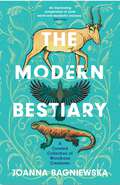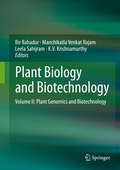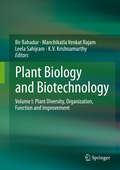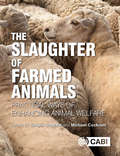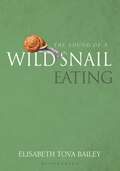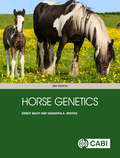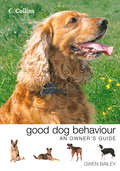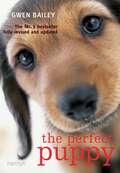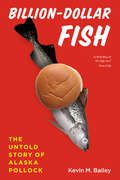- Table View
- List View
Professionalism and Reflection in Veterinary Nursing
by Sue Badger Andrea JefferyProfessionalism and Reflection in Veterinary Nursing Professionalism and Reflection in Veterinary Nursing offers insight into the role of the veterinary nurse in the 21st century. It provides useful information that facilitates a deeper understanding of the underlying theory that supports clinical nursing practice. Exploring concepts that underpin the delivery of professional veterinary nursing, the book covers core issues, themes and principles that explain what it means to be a veterinary nurse. The role of the registered veterinary nurse The registered veterinary nurse’s responsibility to the patient Evidence-based veterinary nursing Veterinary nurse trainer and educator resources A timely publication due to the increased recognition and expectations of the role of the veterinary nursing profession, Professionalism and Reflection in Veterinary Nursing is ideal for veterinary student nurses and qualified veterinary nurses, enabling them to contribute to the development of the professional identity.
The Natural History of Rabies
by George M. BaerThis book provides essential worldwide reference information regarding rabies for public health officials, veterinarians, physicians, virologists, epidemiologists, infectious disease specialists, laboratory diagnosticians, and wildlife biologists. The book is divided into six main sections, covering topics such as the rabies virus, including antigenic and biochemical characteristics; pathogenesis, including the immune response to the infection, pathology, and latency; diagnostic techniques; rabies epidemiology in a variety of wild and domestic animals; rabies control, including vaccination of wild and domestic animals, as well as control on the international level; and finally a discussion of rabies in humans, local wound and serum treatment, and human post-exposure vaccination. Natural History of Rabies, First Edition has been the principal worldwide reference since 1975. The new Second Edition has been completely updated, providing current information on this historically deadly disease.
The Natural History of Rabies: Volume Ii
by George M. BaerThis book provides essential worldwide reference information regarding rabies for public health officials, veterinarians, physicians, virologists, epidemiologists, infectious disease specialists, laboratory diagnosticians, and wildlife biologists. The book is divided into six main sections, covering topics such as the rabies virus, including antigenic and biochemical characteristics; pathogenesis, including the immune response to the infection, pathology, and latency; diagnostic techniques; rabies epidemiology in a variety of wild and domestic animals; rabies control, including vaccination of wild and domestic animals, as well as control on the international level; and finally a discussion of rabies in humans, local wound and serum treatment, and human post-exposure vaccination. Natural History of Rabies, First Edition has been the principal worldwide reference since 1975. The new Second Edition has been completely updated, providing current information on this historically deadly disease.
Norah's Ark (Mills And Boon Silhouette Ser.)
by Judy BaerHi, my name is Bentley. I'm a mutt with a dash of pit bull in the soup, and I have issues. I'm not likely to win any beauty pageants, and I'm afraid of cats. But my human, Norah Kent, thinks I'm the greatest despite all my shortcomings.
Biological Neural Networks: Hierarchical Concept Of Brain Function
by Konstantin V. BaevThis book is devoted to a novel conceptual theoretical framework of neuro science and is an attempt to show that we can postulate a very small number of assumptions and utilize their heuristics to explain a very large spectrum of brain phenomena. The major assumption made in this book is that inborn and acquired neural automatisms are generated according to the same func tional principles. Accordingly, the principles that have been revealed experi mentally to govern inborn motor automatisms, such as locomotion and scratching, are used to elucidate the nature of acquired or learned automat isms. This approach allowed me to apply the language of control theory to describe functions of biological neural networks. You, the reader, can judge the logic of the conclusions regarding brain phenomena that the book derives from these assumptions. If you find the argument flawless, one can call it common sense and consider that to be the best praise for a chain of logical conclusions. For the sake of clarity, I have attempted to make this monograph as readable as possible. Special attention has been given to describing some of the concepts of optimal control theory in such a way that it will be under standable to a biologist or physician. I have also included plenty of illustra tive examples and references designed to demonstrate the appropriateness and applicability of these conceptual theoretical notions for the neurosciences.
The Physiological Basis of Veterinary Clinical Pharmacology
by J. Desmond BaggotThe diversity of species in which drugs are used for clinical purposes and the emphasis on various classes of drugs make veterinary pharmacology a complex subject. Anatomical and physiological features influence the pharmacokinetic behaviour of a drug in a particular animal and the dosage required. This book is concerned with the basis of species differences, the selection of pharmacokinetic parameters and the interpretation of values obtained. There are chapters on bioavailability and its application to veterinary dosage forms, changes in drug disposition and interspecies scaling, clinical selectivity and stereoisomerism, drug permeation, antimicrobial disposition and specifics related to neonatal animals. The author has gathered all this information together in one place so allowing the reader to make better selection of drug preparations for animal dosages to effectively treat animal diseases. The book will prove valuable to clinical researchers in the areas of pharmacology, anaesthesia, microbial infections and, internal medicine as well as postgraduate students of these disciplines. The Author J Desmond Baggot (MVM, PhD, DSc, FRCVS, DipECVPT) is currently Visiting Professor of Veterinary Pharmacology at the School of Veterinary Medicine, St George's University, Grenada, West Indies. He was a contributing author and co-author of Antimicrobial Therapy in Veterinary Medicine, 3rd Edition (2000) and Development and Formulation of Veterinary Dosage Forms, 2nd Edition (1998) and the author of Principles of Drug Disposition in Domestic Animals (1977). Elucidations of the processes that underline species variation in the disposition of drugs and interpretation of the influence of disease states on drug disposition have been the focus of his research endeavours. He was a member of the Editorial Board of the Journal of Veterinary Pharmacology and Therapeutics from 1978 to 1996. He is a former Professor of Clinical Pharmacology at the School of Veterinary Medicine, University of California, Davis and Preclinical Veterinary Studies at the University of Zimbabwe, Harare.
Biology and Ecology of the Brown and Sea Trout: State of the Art and Research Themes (pdf)
by J. L. Bagliniere Gerard MaisseBoomerang!: The Enviro Kids
by Neville BagnallEleven-year-old KATTY and her younger brother JAKE come together to form the 'Enviro Kids', but they still play, bicker, and fight. MUM and DAD do their parenting duties but only when they are not bickering themselves over the chocolate brownies. Mum is going to miss her chocolate brownies. So too is Dad! SERGIO complains about chopped down trees and burning fires of destruction of the forest. Animals perish in the fires; animals are orphaned in the chaos and destruction. Soot clings to everything; trees die forever. The rainforest is disappearing - the lungs of the Earth are wheezing. This is everybody's environment and everybody's planet. Katty and Jake are on a mission, and the battle is on against the filthy pollutants. With the help of their school science teacher, MISS VIOLET, things were going to change before it was too late. Miss Violet conducts pollution experiments, and they begin a crusade to help the Amazon rainforest and to start their tree planting campaign. Katty is one small girl in a very big world who witnesses deforestation. There are a handful of suspects and a lot more baddies.The rainforest is filled with eerie chitter-chatter whispers. All aboard the journey of discovery, where nothing is as it seems! Everything is burning out of control. Time is running out. Seriously! The trees are burning; the forest is disappearing. A mystery story that is not actually a mystery! Get it? Oh, you defo will get it. Boomerang! is a children's story detailing the adventures of Katty, her brother Jake and their parents as they travel to the Amazon rainforest. Amongst other things, they discover magical trees called the Mystrees, come face to face with a caiman crocodile and meet a talking owl. With these mystical elements, the story has many aspects that are enjoyed in children's stories in the current market. But what is unique here is the way the author delicately, but with conviction, addresses the issues of climate change in a way that children will understand. This is the biggest strength of the story. The writing goes up a gear when the animals, the pollutants and Katty talk about the environmental issues and so it's clear that this is something the author is passionate about. Overall, it's a fun story about family but also about standing up for the environmental issues you believe in.
The Modern Bestiary: A Curated Collection of Wondrous Creatures
by Joanna Bagniewska'An illuminating compendium of some weird and wonderful creatures.' ObserverFrom the familiar to the improbable, the gross to the endearing, The Modern Bestiary is a compendium of curious creatures. It includes both animals that have made headlines and those you've probably never heard of, such as skin-eating caecilians, harp sponges, or zombie worms - also known as bone-eating snot flowers. Arranged by elements (Earth, Water, Air), The Modern Bestiary contains well-known species told from new, unexpected angles (rats that drive cars; fish that communicate by passing wind), as well as stranger and lesser-known creatures, including carnivorous mice that howl at the moon, cross-dressing cuttlefish, and antechinuses - small marsupials that literally mate themselves to death. Finally, there are the 'aliens on Earth' - the incredible, the surreal, the magical - such as tardigrades, tongue-eating lice and immortal jellyfish, creatures so astonishing that they make unicorns look rather commonplace.Written by a zoologist with a flair for storytelling, this is a fascinating celebration of the animal kingdom.' [A] beautifully written book to make you laugh, squirm and - perhaps most importantly - appreciate how lucky we are to not have to live inside an anus.' Yussef Rafik'The Modern Bestiary provides a fascinating, accessible and humorous insight into the wonders of the natural world.' Amy Dickman, director of Oxford University's Wildlife Conservation Research Unit 'If you love animals, especially ones with unsavoury habits, this book is for you. Entries are crafted with affection, cast-iron scholarship and an unyielding dedication to exposing as much hilarious weirdness as the animal kingdom can offer.' Tom Moorhouse, author of Elegy for a River'Everyone who loves wildlife - especially fantastically weird and cringingly gross wildlife - should read this masterful book.' Mark Carwardine, author/presenter of Last Chance to See'If ever there was a book that highlighted the bewildering wonders of the natural world, and the need for their conservation, this is it.' Michael Brooke, author of Far from Land
Plant Biology and Biotechnology: Volume II: Plant Genomics and Biotechnology
by Bir Bahadur Manchikatla Venkat Rajam Leela Sahijram K. V. KrishnamurthyPlant genomics and biotechnology have recently made enormous strides, and hold the potential to benefit agriculture, the environment and various other dimensions of the human endeavor. It is no exaggeration to claim that the twenty-first century belongs to biotechnology. Knowledge generation in this field is growing at a frenetic pace, and keeping abreast of the latest advances and calls on us to double our efforts. Volume II of this two-part series addresses cutting-edge aspects of plant genomics and biotechnology. It includes 37 chapters contributed by over 70 researchers, each of which is an expert in his/her own field of research.Biotechnology has helped to solve many conundrums of plant life that had long remained a mystery to mankind. This volume opens with an exhaustive chapter on the role played by thale cress, Arabidopsis thaliana, which is believed to be the Drosophila of the plant kingdom and an invaluable model plant for understanding basic concepts in plant biology. This is followed by chapters on bioremediation, biofuels and biofertilizers through microalgal manipulation, making it a commercializable prospect; discerning finer details of biotic stress with plant-fungal interactions; and the dynamics of abiotic and biotic stresses, which also figure elsewhere in the book.Breeding crop plants for desirable traits has long been an endeavor of biotechnologists. The significance of molecular markers, marker assisted selection and techniques are covered in a dedicated chapter, as are comprehensive reviews on plant molecular biology, DNA fingerprinting techniques, genomic structure and functional genomics. A chapter dedicated to organellar genomes provides extensive information on this important aspect. Elsewhere in the book, the newly emerging area of epigenetics is presented as seen through the lens of biotechnology, showcasing the pivotal role of DNA methylation in effecting permanent and transient changes to the genome. Exclusive chapters deal with bioinformatics and systems biology. Handy tools for practical applications such as somatic embryogenesis and micropropagation are included to provide frontline information to entrepreneurs, as is a chapter on somaclonal variation.Overcoming barriers to sexual incompatibility has also long been a focus of biotechnology, and is addressed in chapters on wide hybridization and hybrid embryo rescue. Another area of accomplishing triploids through endosperm culture is included as a non-conventional breeding strategy. Secondary metabolite production through tissue cultures, which is of importance to industrial scientists, is also covered.Worldwide exchange of plant genetic material is currently an essential topic, as is conserving natural resources in situ. Chapters on in vitro conservation of extant, threatened and other valuable germplasms, gene banking and related issues are included, along with an extensive account of the biotechnology of spices – the low-volume, high-value crops. Metabolic engineering is another emerging field that provides commercial opportunities. As is well known, there is widespread concern over genetically modified crops among the public. GM crops are covered, as are genetic engineering strategies for combating biotic and abiotic stresses where no other solutions are in sight. RNAi- and micro RNA- based strategies for crop improvement have proved to offer novel alternatives to the existing non-conventional techniques, and detailed information on these aspects is also included. The book’s last five chapters are devoted to presenting the various aspects of environmental, marine, desert and rural biotechnology. The state-of-the-art coverage on a wide range of plant genomics and biotechnology topics will be of great interest to post-graduate students and researchers, including the employees of seed and biotechnology companies, and to instructors in the fields of plant genetics, breeding and biotechnology.
Plant Biology and Biotechnology: Volume I: Plant Diversity, Organization, Function and Improvement
by Bir Bahadur Manchikatla Venkat Rajam Leela Sahijram K. V. KrishnamurthyThis volume offers a much-needed compilation of essential reviews on diverse aspects of plant biology, written by eminent botanists. These reviews effectively cover a wide range of aspects of plant biology that have contemporary relevance. At the same time they integrate classical morphology with molecular biology, physiology with pattern formation, growth with genomics, development with morphogenesis, and classical crop-improvement techniques with modern breeding methodologies. Classical botany has been transformed into cutting-edge plant biology, thus providing the theoretical basis for plant biotechnology.It goes without saying that biotechnology has emerged as a powerful discipline of Biology in the last three decades. Biotechnological tools, techniques and information, used in combination with appropriate planning and execution, have already contributed significantly to economic growth and development. It is estimated that in the next decade or two, products and processes made possible by biotechnology will account for over 60% of worldwide commerce and output. There is, therefore, a need to arrive at a general understanding and common approach to issues related to the nature, possession, conservation and use of biodiversity, as it provides the raw material for biotechnology. More than 90% of the total requirements for the biotechnology industry are contributed by plants and microbes, in terms of goods and services. There are however substantial plant and microbial resources that are waiting for biotechnological exploitation in the near future through effective bioprospection. In order to exploit plants and microbes for their useful products and processes, we need to first understand their basic structure, organization, growth and development, cellular process and overall biology. We also need to identify and develop strategies to improve the productivity of plants.In view of the above, in this two-volume book on plant biology and biotechnology, the first volume is devoted to various aspects of plant biology and crop improvement. It includes 33 chapters contributed by 50 researchers, each of which is an expert in his/her own field of research. The book begins with an introductory chapter that gives a lucid account on the past, present and future of plant biology, thereby providing a perfect historical foundation for the chapters that follow. Four chapters are devoted to details on the structural and developmental aspects of the structures of plants and their principal organs. These chapters provide the molecular biological basis for the regulation of morphogenesis of the form of plants and their organs, involving control at the cellular and tissue levels. Details on biodiversity, the basic raw material for biotechnology, are discussed in a separate chapter, in which emphasis is placed on the genetic, species and ecosystem diversities and their conservation.Since fungi and other microbes form an important component of the overall biodiversity, special attention is paid to the treatment of fungi and other microbes in this volume. Four chapters respectively deal with an overview of fungi, arbuscularmycorrhizae and their relation to the sustenance of plant wealth, diversity and practical applications of mushrooms, and lichens (associated with a photobiont). Microbial endosymbionts associated with plants and phosphate solubilizing microbes in the rhizosphere of plants are exhaustively treated in two separate chapters. The reproductive strategies of bryophytes and an overview on Cycads form the subject matter of another two chapters, thus fulfilling the need to deal with the non-flowering Embryophyte group of plants.Angiosperms, the most important group of plants from a biotechnological perspective, are examined exhaustively in this volume. The chapters on angiosperms provide an overview and cover the genetic basis of flowers development, pre-and post-fertilization reproductive growth and development, seed biology and technology, plant secondary metabolism, photosynthesis, and plant volatile chemicals. A special effort ha
The Slaughter of Farmed Animals: Practical ways of enhancing animal welfare
by Faith Baier Miki Ben-Dor Lotta Berg Lily N. Edwards-Callaway Helen Kline Andy Lamey F Leroy Frank Mitloehner Mohan Raj Bernard Rollin Peter Singer Claudia Terlouw Dennis Wilson Erika VoogdThis book provides both evidence-based scientific studies and practical guidance to enhance the welfare of cattle, pigs, sheep and poultry at slaughter. Temple Grandin and Michael Cockram have brought together a range of international experts to prepare chapters on philosophical and ethical views on the slaughter of farmed animals. These include welfare issues and their assessment, the condition of animals on arrival and their management during lairage, animal handling, methods of humane slaughter and assessment of unconsciousness. The book boldly tackles controversial issues around the compromises necessary when balancing animal welfare concerns with commercial realities, as well as religious slaughter. Chapters cover methods of stunning, pre-slaughter handling, equipment design, monitoring welfare with abattoir data and auditing methods. It is an important publication for those involved in implementing improvements in the humane slaughter of farmed animals and is recommended for veterinarians, students, abattoir managers and government regulators.
whiskerslist: the kitty classifieds
by Angie BaileyWhen the humans are away, the cats will play . . . onlineDo you ever wonder what your cat does when you're not home? Is your keyboard covered with mysterious paw prints? Well, your feline friend might be hiding a secret Internet addiction: whiskerslist. The kitty community is more connected than ever with this online hub that brings together cats looking to sell lousy pet toys, rant about their humans, search for a soul mate (or quick hookup), and much more.With more than 160 hilarious classified ads written for cats, by cats, whiskerslist reveals the inner lives of our furry companions like never before.
The Sound of a Wild Snail Eating
by Elisabeth Tova BaileyThe delightful account of how a close connection with nature brought joy to a woman incapacitated through illness.While an illness keeps her bedridden, Elisabeth Bailey watches a wild snail that has taken up residence in a terrarium alongside her bed. She enters the rhythm of life of this mysterious creature, and comes to a greater understanding of her own confined place in the world. In a work that beautifully demonstrates the rewards of closely observing nature, she shares the inspiring and intimate story of her close encounter with Neohelix albolabris – a common woodland snail.Intrigued by the snail's world – from its strange anatomy to its mysterious courtship activities – she becomes a fascinated and amused observer of the snail's curious life. The Sound of a Wild Snail Eating is an affirmation of the healing power of nature, revealing how much of the world we miss in our busy daily lives, and how truly magical it is.A remarkable journey of survival and resilience, The Sound of a Wild Snail Eating shows how a small part of the natural world can illuminate our own human existence and deepen our appreciation of what it means to be fully alive.
Horse Genetics
by Ernest Bailey Samantha A BrooksCompletely updated and revised, the third edition of this essential textbook describes the basic genetics of the horse including coat colour, parentage, medical and population genetics, cytogenetics, performance, breeding systems and genetic conservation, as well as the many recent advances in genomics. New for the third edition: - More information on genomics and biology have been included - There are two additional chapters on genetics with respect to infectious diseases and reproduction - Expanded sections on quantitative genetics and genomic selection provide comprehensive coverage - Many new figures further illustrate key points in the text - Redesigned in colour throughout and keeping the popular features of previous editions This authoritative text remains one of the key sources of information for basic genetic principles and their specific applications to the horse, and is essential for students of equine studies, animal breeding and veterinary science, as well as horse breeders and owners.
The Battersea Dogs and Cats Home: Choosing The Right Dog For You
by Gwen BaileyThe world's oldest and most famous cat and dog home has teamed up with the UK bestselling pet behaviourist to bring you the ultimate guide to choosing the right dog for you and your family.There are over 200 breeds profiled, with details of each dog's temperament, physical statistics, character, exercise requirements and potential health problems. Each profile includes a picture and a list of its key characteristics, making this the most comprehensive breed-profile book on the market.A front section gives advice on what sort of breed you should look for and how to go about finding your dog. It also tells you what to ask, what to consider and ensures you don't make a mistake in your decisions.If you're thinking about getting a dog, or want to learn more about the variety of breeds, cross-breeds and mongrels, then you cannot afford to be without this book.
Collins Good Dog Behaviour: An Owner's Guide
by Gwen BaileyPublished in association with The Blue Cross, one of Britain’s top animal welfare societies, ‘Collins Good Dog Behaviour’ is an essential handbook for all responsible dog owners with numerous step-by-step photographs that will help to make training your dog simple and enjoyable.
Hell On 4 Paws: How Britain’s leading Pet Behaviourist met her match
by Gwen BaileyAs a bestselling author and owner of the Puppy School franchise, Gwen Bailey is one of the UK's most respected dog behaviour experts and has helped millions to transform their troublesome pets into obedient and happy hounds. So what happened when one of her students - Chesil, the most dysfunctional pooch in Britain - refused to lay down, and he just so happened to be her own dog?!Hell On 4 Paws is the witty and wonderful story of how Gwen's life was turned on its head when she took on a new man in her life, his family, and the unruly Chesil, her greatest challenge yet. As if adjusting to a new relationship, new home and new responsibilities wasn't tough enough, Gwen also has to deal with Chesil's bizarre and antisocial behaviour, a constant distraction in her crazy new life. Follow Chesil's amusing exploits as his outrageous personality clashes with Gwen's time-tested techniques, and see him slowly change from an aggressive, possessive nightmare to a proud winner of the Gold Award for good citizenship. A feel-good and inspirational tale for anyone who's ever had trouble raising a rowdy hound, Hell On 4 Paws shows that sometimes even the best trainers can encounter problems, and that, with a little persistence, even the worst pets can become compassionate creatures.
The Natural Dog: A New Approach to Achieving a Happy, Healthy Hound
by Gwen BaileyWant to learn what your pet naturally needs?Gwen Bailey's bestselling dog guides have helped hundreds of thousands of owners throughout the world. Now, in this brand new book, you can learn how give your dog everything it needs to achieve a happy and happy life by focusing on three vital considerations:- Physical health: Sticks, exercise games, vaccination and more- Dietary health: Hydration, diet, dental health, recipes and feeding- Mental health: Stimulation, socialization and canine interaction, addressing aggressive behaviour and introducing other petsFrom understanding your dog's physiognomy and analysing the perfect diet, to keeping your dog naturally alert, spirited and happy throughout its life, The Naturally Dog offers a holistic approach to changing your dog's lifestyle to get the most out of life. This is the wellness bible for dog owners everywhere.
Perfect Puppy: The No.1 bestseller fully revised and updated
by Gwen BaileyNEW EDITION OUT AUGUST 2024 Gwen Bailey's puppy care guide has helped hundreds of thousands of owners throughout the world raise a problem-free dog. Now, updated with the latest findings in canine behaviour and a completely new user-friendly design, this revised edition will teach you how to raise a problem-free dog. From housetraining to playing games, it will show you how to teach your dog good manners and build his confidence with the world around him. There are step-by-step training and socialisation plans as well as a guide to understanding and preventing biting, chewing and other problems.If you want your puppy to develop into a happy, well-behaved and friendly adult dog, you cannot afford to be without this book.
Billion-Dollar Fish: The Untold Story of Alaska Pollock
by Kevin M. BaileyAlaska pollock is everywhere. If you’re eating fish but you don’t know what kind it is, it’s almost certainly pollock. Prized for its generic fish taste, pollock masquerades as crab meat in california rolls and seafood salads, and it feeds millions as fish sticks in school cafeterias and Filet-O-Fish sandwiches at McDonald’s. That ubiquity has made pollock the most lucrative fish harvest in America—the fishery in the United States alone has an annual value of over one billion dollars. But even as the money rolls in, pollock is in trouble: in the last few years, the pollock population has declined by more than half, and some scientists are predicting the fishery’s eventual collapse. In Billion-Dollar Fish, Kevin M. Bailey combines his years of firsthand pollock research with a remarkable talent for storytelling to offer the first natural history of Alaska pollock. Crucial to understanding the pollock fishery, he shows, is recognizing what aspects of its natural history make pollock so very desirable to fish, while at the same time making it resilient, yet highly vulnerable to overfishing. Bailey delves into the science, politics, and economics surrounding Alaska pollock in the Bering Sea, detailing the development of the fishery, the various political machinations that have led to its current management, and, perhaps most important, its impending demise. He approaches his subject from multiple angles, bringing in the perspectives of fishermen, politicians, environmentalists, and biologists, and drawing on revealing interviews with players who range from Greenpeace activists to fishing industry lawyers. Seamlessly weaving the biology and ecology of pollock with the history and politics of the fishery, as well as Bailey’s own often raucous tales about life at sea, Billion-Dollar Fish is a book for every person interested in the troubled relationship between fish and humans, from the depths of the sea to the dinner plate.
Billion-Dollar Fish: The Untold Story of Alaska Pollock
by Kevin M. BaileyAlaska pollock is everywhere. If you’re eating fish but you don’t know what kind it is, it’s almost certainly pollock. Prized for its generic fish taste, pollock masquerades as crab meat in california rolls and seafood salads, and it feeds millions as fish sticks in school cafeterias and Filet-O-Fish sandwiches at McDonald’s. That ubiquity has made pollock the most lucrative fish harvest in America—the fishery in the United States alone has an annual value of over one billion dollars. But even as the money rolls in, pollock is in trouble: in the last few years, the pollock population has declined by more than half, and some scientists are predicting the fishery’s eventual collapse. In Billion-Dollar Fish, Kevin M. Bailey combines his years of firsthand pollock research with a remarkable talent for storytelling to offer the first natural history of Alaska pollock. Crucial to understanding the pollock fishery, he shows, is recognizing what aspects of its natural history make pollock so very desirable to fish, while at the same time making it resilient, yet highly vulnerable to overfishing. Bailey delves into the science, politics, and economics surrounding Alaska pollock in the Bering Sea, detailing the development of the fishery, the various political machinations that have led to its current management, and, perhaps most important, its impending demise. He approaches his subject from multiple angles, bringing in the perspectives of fishermen, politicians, environmentalists, and biologists, and drawing on revealing interviews with players who range from Greenpeace activists to fishing industry lawyers. Seamlessly weaving the biology and ecology of pollock with the history and politics of the fishery, as well as Bailey’s own often raucous tales about life at sea, Billion-Dollar Fish is a book for every person interested in the troubled relationship between fish and humans, from the depths of the sea to the dinner plate.
Billion-Dollar Fish: The Untold Story of Alaska Pollock
by Kevin M. BaileyAlaska pollock is everywhere. If you’re eating fish but you don’t know what kind it is, it’s almost certainly pollock. Prized for its generic fish taste, pollock masquerades as crab meat in california rolls and seafood salads, and it feeds millions as fish sticks in school cafeterias and Filet-O-Fish sandwiches at McDonald’s. That ubiquity has made pollock the most lucrative fish harvest in America—the fishery in the United States alone has an annual value of over one billion dollars. But even as the money rolls in, pollock is in trouble: in the last few years, the pollock population has declined by more than half, and some scientists are predicting the fishery’s eventual collapse. In Billion-Dollar Fish, Kevin M. Bailey combines his years of firsthand pollock research with a remarkable talent for storytelling to offer the first natural history of Alaska pollock. Crucial to understanding the pollock fishery, he shows, is recognizing what aspects of its natural history make pollock so very desirable to fish, while at the same time making it resilient, yet highly vulnerable to overfishing. Bailey delves into the science, politics, and economics surrounding Alaska pollock in the Bering Sea, detailing the development of the fishery, the various political machinations that have led to its current management, and, perhaps most important, its impending demise. He approaches his subject from multiple angles, bringing in the perspectives of fishermen, politicians, environmentalists, and biologists, and drawing on revealing interviews with players who range from Greenpeace activists to fishing industry lawyers. Seamlessly weaving the biology and ecology of pollock with the history and politics of the fishery, as well as Bailey’s own often raucous tales about life at sea, Billion-Dollar Fish is a book for every person interested in the troubled relationship between fish and humans, from the depths of the sea to the dinner plate.
Billion-Dollar Fish: The Untold Story of Alaska Pollock
by Kevin M. BaileyAlaska pollock is everywhere. If you’re eating fish but you don’t know what kind it is, it’s almost certainly pollock. Prized for its generic fish taste, pollock masquerades as crab meat in california rolls and seafood salads, and it feeds millions as fish sticks in school cafeterias and Filet-O-Fish sandwiches at McDonald’s. That ubiquity has made pollock the most lucrative fish harvest in America—the fishery in the United States alone has an annual value of over one billion dollars. But even as the money rolls in, pollock is in trouble: in the last few years, the pollock population has declined by more than half, and some scientists are predicting the fishery’s eventual collapse. In Billion-Dollar Fish, Kevin M. Bailey combines his years of firsthand pollock research with a remarkable talent for storytelling to offer the first natural history of Alaska pollock. Crucial to understanding the pollock fishery, he shows, is recognizing what aspects of its natural history make pollock so very desirable to fish, while at the same time making it resilient, yet highly vulnerable to overfishing. Bailey delves into the science, politics, and economics surrounding Alaska pollock in the Bering Sea, detailing the development of the fishery, the various political machinations that have led to its current management, and, perhaps most important, its impending demise. He approaches his subject from multiple angles, bringing in the perspectives of fishermen, politicians, environmentalists, and biologists, and drawing on revealing interviews with players who range from Greenpeace activists to fishing industry lawyers. Seamlessly weaving the biology and ecology of pollock with the history and politics of the fishery, as well as Bailey’s own often raucous tales about life at sea, Billion-Dollar Fish is a book for every person interested in the troubled relationship between fish and humans, from the depths of the sea to the dinner plate.
Billion-Dollar Fish: The Untold Story of Alaska Pollock
by Kevin M. BaileyAlaska pollock is everywhere. If you’re eating fish but you don’t know what kind it is, it’s almost certainly pollock. Prized for its generic fish taste, pollock masquerades as crab meat in california rolls and seafood salads, and it feeds millions as fish sticks in school cafeterias and Filet-O-Fish sandwiches at McDonald’s. That ubiquity has made pollock the most lucrative fish harvest in America—the fishery in the United States alone has an annual value of over one billion dollars. But even as the money rolls in, pollock is in trouble: in the last few years, the pollock population has declined by more than half, and some scientists are predicting the fishery’s eventual collapse. In Billion-Dollar Fish, Kevin M. Bailey combines his years of firsthand pollock research with a remarkable talent for storytelling to offer the first natural history of Alaska pollock. Crucial to understanding the pollock fishery, he shows, is recognizing what aspects of its natural history make pollock so very desirable to fish, while at the same time making it resilient, yet highly vulnerable to overfishing. Bailey delves into the science, politics, and economics surrounding Alaska pollock in the Bering Sea, detailing the development of the fishery, the various political machinations that have led to its current management, and, perhaps most important, its impending demise. He approaches his subject from multiple angles, bringing in the perspectives of fishermen, politicians, environmentalists, and biologists, and drawing on revealing interviews with players who range from Greenpeace activists to fishing industry lawyers. Seamlessly weaving the biology and ecology of pollock with the history and politics of the fishery, as well as Bailey’s own often raucous tales about life at sea, Billion-Dollar Fish is a book for every person interested in the troubled relationship between fish and humans, from the depths of the sea to the dinner plate.







